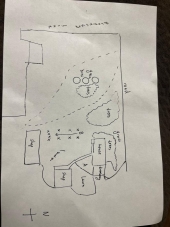Recently I’ve been reconsidering the idea of hugelkultur and now every time I look around my property I feel a bit like hugelkultur Oprah…”you get a hugel! You get a hugel! Everybody gets a hugel!”
Before I start creating massive mounds everywhere I thought it best to let some cooler heads prevail and lend me some advice as I have 0 experience with hugelkultur (and really my thumb is rather yellow, I’m more of a livestock person). SW North Dakota, 15-20” of rainfall annually, mostly in May and June with a few timely rains falling outside that window usually. Zone 4ish, I tend to err on the side of zone 3. Heavy clay soil.
The first two locations I’m considering for hugel would be A and B in the diagram of my yard. A was formerly a rock garden (thanks to the previous owners) which fortunately got dug out last year in a water line leak situation. Unfortunately, while I had plans to eventually tear it out, that was a lot further down the 20 year plan for this property. Either way, I now have a space of bare dirt that is dug down about 6-8 inches below the level of the concrete sidewalk that borders the house and also runs from the house to the shop. I need to fill it in with something, why not a bunch of logs/brush and then compost/soil? I would not mound this area up significantly, just get it back to level with the concrete. I would likely cover crop it for a few years until I have the time and money to establish the native flowers/ grass garden that I want there. The goal for this bed is to have a nice aesthetic close to the house while providing native pollinators and other critters some habitat, and also to have it be semi-low maintenance, hence native plants that should naturally thrive here anyway. Pros/cons to this hugel idea for this space?
Space B would be a hugel mound running in between the trees (marked by x) in the mini orchard I’m in the process of establishing. I’d like to use the “fruit tree guild” concept here, the only real reasons for the hugel would be to use up excess brush laying around, create a bed for the guild plants that would require minimal watering, and ?possibly? create a tall spot to stand on that might help with harvesting apple trees, although if it’s too steep I feel it would only inhibit the ability to use a ladder where necessary. I’m kind of thinking this one is a no go unless somebody has strong reasons to advocate for it.
The next would be near my existing, but abandoned, vegetable garden. I could create a series of hugels near the greenhouse/winter chicken coop/multipurpose building that I want to add to the garden area. About 30 yards away I have a massive (see picture) pile of trees/brush/etc that’s been piling up since before we moved here. It’s probably 15’ tall x 15’ wide x 30’ long. We also have lots of dead and dying trees (keep in mind that when I say lots this is coming from someone who lives on a prairie, some of you forest dwellers may disagree) that need to come down. We are ranchers and I have access to nearly 200 cows worth of manure, hay, and straw, some of which has been nicely piled up and composting away for several years now, as well as smaller amounts of sheep, horse, and chicken manure. Oh, and I also have a nice big loader tractor that can move those logs and manure nice and easy. So, the question is whether to build hugels and use all that up or just amend my flat garden with wood chips and leaf mold and cover crops. Some helpful info: I don’t need to vertically garden for space reason, I have more space than I know what to do with. The advantage to hugelkultur for me would be the soil quality and, mostly, the minimal watering. Whichever way I go, I’m willing to wait for soil improvements. I have a 3 year old and a 3 month old, and between the livestock and grain crops and both of us working off the farm, I’ve committed to not doing any annual gardening for the next few years, but I could realistically toss a cover crop in there and run some bum lambs or the chickens through it to graze/ trample it down. Once we’ve hit what we call “the break even point” on the kids, meaning they may not be super useful yet but at least they’re not severely inhibiting the work I can accomplish in a day, I would like to get a lot more serious about gardening and growing our food. Thoughts on hugelkultur vs. amending the flat garden?
The last one is really just a fun thought but probably something I will never get around to. West of the calving barn there is an old shelter belt running north-south, many of the trees are dead or dying. They’re all in a nice row. How cool would it be to just start laying them down one on top of the other, such that the branches of one lay on top of the trunk of the previously felled tree, and then bury it all in the manure/straw/hay mixture we have located so conveniently close. Grow a U-pick strawberry farm or something like that on it. What would you plant?




